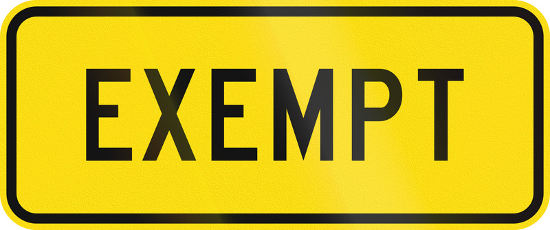
Exempt vs. Non Exempt Employee: A California Law Guide
26 Feb 2019
California and Federal labor law provide employees basic rights such as minimum wage, overtime, and meal periods. Unfortunately, many different types of workers are “exempt” from obtaining these rights. Determining if an individual is an exempt employee in California requires a complicated analysis, usually best served by an employment attorney well versed in labor law.
Knowing this complexity, employers frequently mislead workers who go months and sometimes even years before they find out that they were misclassified and as a result underpaid. Those same employers bank on the ignorance of their employees to increase their profits. Instead of making their businesses more competitive the old fashioned way, they rely on wage theft to artificially prop up their poorly managed companies.
How can workers fight back? Simple, by reading this guide and enlightening themselves about the protections that both the Fair Labor Standards Act (“FLSA”) and California labor law provide. This guide will focus on California law because generally, it offers better protection than the FLSA.
Table of Contents:
What Basic Rights Is a Non-Exempt Employee Entitled To?
The most common rights are:

Minimum Wage: Subject to a few exceptions, all California hourly employees must earn at least the state minimum wage. For the 2019 Calendar year, the state minimum wage is $11.00 per hour for employers with less than 26 employees, and $12.00 an hour for employers with 26 or more employees. In addition, many cities have enacted their own ordinances that employers must abide by. For example, San Francisco’s proposition J ordinance requires that employers pay employees at least $15 an hour (this minimum wage will increase to $15.59 beginning July 1, 2019). Los Angeles meanwhile requires $12.00 per hour for businesses with 25 employees or less (it will hike up to $13.25 beginning July 1, 2019), and $13.25 per hour for business with 26 employees or more (it will hike up to $14.25 beginning July 1, 2019).

Overtime Pay: Employers must also pay their workers overtime at the rate of one and one-half times (1.5X) their regular rate of pay for work performed over: 8 hours in one workday, forty hours in one workweek, or any work performed in the first eight hours on the seventh consecutive day of work in a work week. Workers must also be paid double time (2X) for work performed in excess of: 12 hours in one workday, or eight hours on the seventh consecutive day of work performed in one workweek. For more information check out our California overtime rules guide.

Lunch & Rest Breaks: Employers must authorize and permit employees to take 10-minute net rest periods for every 4 hours of work performed or major fraction thereof. No rest period is needed when total work performed in one workday is less than 3.5 hours. Meal periods that are no less than 30 minutes in duration must ordinarily be provided to any employee that has worked more than 5 hours in one workday. A second meal period of the same length must be provided for any worker who has worked more than 10 hours in one day. Click this link: to learn more read our California Guide to Break Laws.
Wage & Hour Laws Only Apply To Employees
Only employees are covered by wage and hour employment laws and are entitled to overtime, rest breaks, meal breaks, and minimum wage. Independent contractors are excluded.
What is an employer?
The California Industrial Welfare Commissions (“IWC”) defines employer broadly in its Wage Orders as “any person… who directly or indirectly, employs or exercises control over the wages, hours or working conditions of any person.” (8 Cal.C.Regs. § 11140, ¶2(c),(f).) Pursuant to the IWC definition, “employ” means “(a) to exercise control over the wages, hours or working conditions, or (b) to suffer or permit to work, or (c) to engage, thereby creating a common law employment relationship.” (Martinez v. Combs (2010) 49 C4th 35, 64).
California Presumption that A Worker Is An Employee
California law presumes an employer-employee relationship once evidence has been presented showing that a worker provided services for an employer. When this happens the burden shifts to the employer to prove that the presumed employee was an independent contractor. (Narayan v. EGL, Inc. (9th Cir. 2010) 616F3d 895, 900).
Am I an employee or an independent contractor? The ABC Test
The California Supreme Court recently clarified California’s law regarding the proper test that should apply when determining if a particular worker is an independent contractor or an employee. The Court in a comprehensive and straight forward written opinion in the case of Dynamex Operations West, Inc. v. Superior Court of Los Angeles adopted what is nationally known as the “ABC Test.”
Under the test, a worker is correctly classified as an independent contractor if: (1) “the worker is free from the control and direction of the hirer in connection with the performance of the work, both under the contract for the performance of such work and in fact,” (2) “the worker performs work that is outside the usual course of the hiring entity’s business”; and (3) “that the worker is customarily engaged in an independently established trade, occupation, or business of the same nature as the work performed for the hiring entity.” All three elements must be established by the hirer for the worker to truly be considered an independent contractor. In issuing the opinion the Supreme Court substantially changed the law, thereby making the older Borello test referenced below inapplicable. The ABC Test makes it much more difficult for employers to misclassify their employees and maliciously claim they are exempt because it is broader and therefore covers more circumstances. Employers bear the responsibility of having to pay payroll and social security taxes, unemployment insurance taxes, and workers compensation insurance. Some want nothing more than to weasel their way out of these financial burdens. Companies should think twice before pulling any stunts to avoid having to pay overtime, providing meal and rest periods, and denying other rights entitled to employees.
*THIS TEST IS NO LONGER APPLICABLE, SEE ABOVE.* California uses a multi-factor common law test (can be found in California Civil Jury Instructions 3704) for determining whether a worker is an employee or an independent contractor. The most critical factor in this test is whether a hirer has the right to control how the end result is achieved.
The fact-finder (judge or jury depending on the case) uses this multi-factor test and assigns weight to each factor using the nature of the work and the totality of the evidence presented. Answering yes a particular factor would tend to show an employment relationship existed, while answering no would show the individual was more likely an independent contractor. It is important to note that no single factor is solely determinative. The common law factors are:
- Did the putative employer have the right to control the manner and means of performance?
- Did the employment relationship allow termination at will?
- Was the work performed part and parcel of the regular business of the putative employer?
- Was the work performed usually done under the supervision and direction of an employer, rather than by a specialist working without supervision?
- Did the work performed not require any specialized knowledge or professional skill?
- Did the putative employer provide the instrumentalities, tools, and place of work?
- Was there a extended length of time during which the services were performed?
- Was the worker paid by the hour rather than by the job?
- Did the worker and putative employer believe that they had an employer-employee relationship?
The White Collar Exemptions
In general, California’s more restrictive rules make it much tougher for employers to establish that an employee is exempt. As a result, California provides greater protections than its FLSA counterpart. The most common are the white-collar exemptions that apply to professional, administrative and executive employees. All of these exceptions to the rule work to relieve employers from having to provide minimum wage and overtime to certain employees. All three categories of white-collar exemptions (professional, administrative, executive), discussed in detail below, have the following requirements which all must be met under Labor Code section 515(a):
1.) The employee in question must be “primarily engaged in duties that meet the test of the exemption” (check relevant IWC order & see below); and
2.) The employee must “customarily and regularly exercise discretion and independent judgment in performing those duties”; and
3) The employee must earn a monthly salary equivalent to no less than two times (2X) state’s minimum wage for full-time employment. In 2019 this number would be $49,920 per year for those working for large businesses (26 or more employees) and $45,760 for those working for small businesses (25 or fewer employees).
“Primarily Engaged in” means: The employee must spend more than one-half of his or her work time engaged in exempt work.
Executive Exemption:
For this exemption to apply, an employee must (See Wage Order No. 1-2001):
- Have duties and responsibilities that “involve the management of the enterprise in which he/she is employed or of a customarily recognized department or subdivision thereof”; and
- Customarily and regularly direct the work of at least two or more other employees; and
- Have the power to hire and fire, or command power to suggest and recommend the hiring, firing, and promotion, or other change of status of an employee; and
- “Customarily and regularly exercise discretion and independent judgment”; and
- “Primarily engaged in duties which meet the test of exemption” (spends more than 50% of work time engaged in exempt work); and
- Earn a monthly salary of no less than two times (2x) state minimum wage for full-time employment. For 2019 that number should be $45,760 per annum while working for small employers (25 employees or less) or $49,920 per year while working for large employers (26 employees or more).
Professional Exemption:
This exemption applies to any employee who:
- (1) Is licensed or certified by the State of California and is primarily engaged in the practice of one or more of the following professions: medicine, dentistry, law, engineering, optometry, architecture, accounting, teaching; or (2) Is Primarily engaged in an occupation commonly recognized as a learned or artistic profession; and
- Customarily and regularly exercises discretion and independent judgment in the performance of his or her duties; and
- Earn a monthly salary of of no less than two times (2x) state minimum wage for full-time employment. In 2019 that number should be $45,760 per year while working for small employers (25 employees or less) or $49,920 per year while working for large employers (26 employees or more).
Administrative Exemption:
For the exemption to apply, an employee must (See Wage Order No. 1-2001):
- Have duties and responsibilities that involve either: (1) Performing office or non manual work directly related to management policies or general business operations of the employer or the employer’s customers; or (2) Performing functions in the administration of a school system, or educational establishment or institution, or of a department or subdivision of those, in work directly related to the academic instruction or training carried on in the system, establishment, or institution; and
- “Customarily and regularly exercise discretion and independent judgment”; and
- Be “Primarily engaged in duties which meet the test of exemption” (more than 50% of work time spent engaged in work considered exempt); and
- Earn a monthly salary of of no less than two times (2x) state minimum wage for full-time employment. In 2019 that number would be $45,760 per year while working for small employers (25 employees or less) or $49,920 per year while working for large employers (26 employees or more); and
- Who:
- “[R]egularly and directly assist a proprietor or employee employed in a bona fide executive or administrative capacity; or
- Work specialized or technical lines requiring special training, experience, or knowledge, under only general supervision; or
- Execute tasks and special assignments under only general supervision.
Some examples may include but are not limited to:
Tax Preparation;
Accounting;
Quality Control;
Finance;
Legal & Regulatory Compliance; and
Advertising
What If I Am Paid Hourly Instead of Salary?
If an employee is paid on an hourly basis then by definition the white-collar exemptions do not apply. The employee must be paid on a salaried basis that is a guaranteed and predetermined amount. Further, the salary cannot be subject to reduction. Example: In Negri v. Koning & Assocs. (2013) 216 CA4th 392, 397, 156 CR3d 697, 701 an insurance adjuster who was paid based on the number of hours worked without a guaranteed minimum was not subject to the administrative exemption. What this means is simply if that the worker is paid on a hourly basis they are non-exempt, are owed overtime, meal rest periods, and other rights and privileges typically entitled to non-exempt employees (so long as they don’t otherwise fall into another exemption).
What If My Employer Makes Deductions From My Pay for Absences?
Employers may make full-day salary deductions for absences because of vacation, sickness, or personal reasons from their employees pay without affecting the “salary” status. Employers, however, may not make deductions for partial-day absences without affecting their employees’ salary status. Partial day deductions indicate that a particular employee is not “salaried” and therefore not exempt. Partial day deductions, however, may be deducted from an employee’s leave bank without changing the employee’s status as salaried.
Others Exempted From Both Overtime & Minimum Wage Requirements:
Outside Salespersons:
Overtime and minimum wage requirements do not apply to individuals (outside salespersons) who are eighteen years or older and who customarily and regularly work more than 50% of their work time away from their employer’s location of business selling tangible or intangible goods, or obtaining orders or contracts for products, services or use of facilities. (Wage Order Nos. 1–2001—16–2001, §2 (8 Cal Code Regs §§11010–11160, §2).
Computer Professionals:
Employees that work in the computer software field and are primarily engaged in work that is creative or intellectual, which requires the exercise of discretion and independent judgment are exempt (subject to certain conditions being met). (Wage Order No. 1-2001).
Members of Employees’ Families:
Parents, spouses, children, and legally adopted children of employers are also exempted from California wage laws. (See IWC Wage Orders; 8 Cal.C.Regs. § 11010 et seq.)
Sheepherders:
Yes, even sheepherder can be exempt. We are not sure why, but if you plan on going into that industry you better think twice. (8 Cal.C.Regs. § 11140).
Employees That Are Exempt Only From Overtime
Employees Receiving Sales Commission:
Certain individuals are exempt if they: (1.) work in the mercantile industry (Wage Order 7-2001) or professional, technical, clerical, mechanical or similar occupation (Wage Order (4-2001), (2.) selling property or services (3.) their earnings exceed one and one-half times the California minimum wage, and (4.) more than half of their compensation is derived from commission.
Motor Vehicle Drivers
Specific interstate truck drivers are exempted from California overtime. Even drivers who solely drive intrastate may be exempt if their deliveries are a continuation of an interstate journey or if they reasonably could be expected to be called on to make interstate runs. (Bell v. H.F. Cox, Inc. (2012) 209 CA4th 62, 62, 77-78).
Movie Projectionist
Pursuant to California Code of Regulations, Title 8, Section 11100, motion picture projectionists are exempt from overtime.
Private School Teachers
Teachers working in private schools and teaching kindergarten through grade 12 are exempt from overtime. This exemption does not apply, however, to any tutor, teaching assistant, instructional aide, student teacher, daycare provider, vocational instructor, or other similar employee. (Lab C §515.8).


